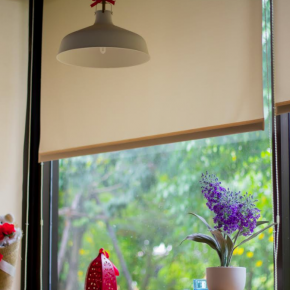
The Environmental Benefits of Blackout Blinds and Curtains
Blackout blinds are a simple way of reducing your personal impact on the environment, according to this article from Terry’s Fabrics.
In a world where it is vital to consider how everyday choices have an environmental impact, it is important to look at all the small changes that can be made in order to become more sustainable.
There are many ways in which individuals can make a bid to become more environmentally friendly, beginning in the home. Taking steps to ensure homes are as energy efficient as possible not only helps reduce the negative effects on the environment but can also incur a number of personal benefits; from improved insulation to reduced energy bills.
The high-quality fabric in blackout blinds helps to ensure a home is insulated, subsequently improving its energy efficiency and reducing your carbon footprint. If heat is escaping your home through the windows, more energy will be used, which in turn increases your carbon footprint.

The Importance of Sustainability
Not only is a reduction in energy consumption a welcome idea in terms of cost, but also in terms of the environmental impact. With so much focus on the current condition of the environment and global warming’s impact, it is more crucial than ever to consider the ways in which energy consumption and waste can be avoided or reduced.
Switching to blackout blinds or curtains is just one way to reduce energy consumption and save financially in the long run.
Improved Insulation
The material used for blackout blinds and curtains is extremely tightly woven, high quality fabric. For this reason, it does an impeccable job of insulating a room.
Blackout blinds are synonymous with usage in summer months, in terms of keeping out light when we want to go to sleep and blocking sunlight from heating up our homes when we want to keep them cool.
However, they also do the opposite – the high-quality material used for blackout blinds can also help keep heat in, ideal for those colder months.
The insulation provided by blackout blinds and curtains subsequently can reduce energy bills; as more heat will be retained, energy is less likely to be wasted.
As winter generally means an increase in bills, this reduction will be welcome.
Using Blackout Blinds and Curtains in Your Home
There are a few different ways to consider utilising blackout blinds and curtains in your home. Not only are they ideal for bedrooms, as they guarantee a better quality sleep, but they are ideal in rooms which tend to get a lot of light or rooms with large or multiple windows.

Living Room
Living rooms tend to be one of the biggest areas in the house – they generally have large windows and more than one of them, therefore would be typically the most likely place that energy would be lost in winter, and encounter light pollution in summer.
Whilst blinds may not be aesthetically fitting for large windows, blackout curtains can be ideal! Alternatively, pair blackout blinds with a sheer curtain for a layered look.
Kitchen
You may not always consider blackout blinds being essential in the kitchen, however for privacy and heat retention purposes they make a great choice. With such a variety of styles and patterns available, it is easy to find something to match your décor.

Bedrooms
Bedrooms are generally where blackout blinds will be found in most homes, as this ensures a better night’s sleep, even in lighter months. As with the living room, pair some made to measure window blinds with some beautiful curtains for a practical yet stylish look.
With so many different options and ways to utilise blackout blinds and curtains in the home, it is easy to become both more energy efficient and ensure a focus on sustainability. Not only will you be doing your bit for the environment but also potentially reducing monthly energy bills.
Latest news

28th March 2025
Ideal Heating Commercial announces 10-year warranty on Evomax 2 boiler
Evomax 2, the UK’s number one selling commercial wall-mounted boiler from Ideal Heating Commercial, is now available with a 10-year warranty.
Posted in Articles, Building Industry News, Building Products & Structures, Building Regulations & Accreditations, Building Services, Facility Management & Building Services, Heating Systems, Controls and Management, Heating, Ventilation and Air Conditioning - HVAC, Innovations & New Products, Pipes, Pipes & Fittings, Plumbing, Retrofit & Renovation, Sustainability & Energy Efficiency, Videos
28th March 2025
FLIR Si1-LD Acoustic Imaging Camera for Compressed Air Leak Detection
FLIR, a Teledyne Technologies company, introduces the Si1-LD, an industrial acoustic imaging camera that brings faster and more accurate compressed air leak detection to those operating on a modest condition monitoring budget.
Posted in Acoustics, Noise & Vibration Control, Articles, Building Industry News, Building Products & Structures, Building Services, Facility Management & Building Services, Information Technology, Innovations & New Products, Retrofit & Renovation, Sustainability & Energy Efficiency, Thermal Imaging and Monitors
28th March 2025
LIFTEX 2025 Seminar programme announced
Registration has opened for LIFTEX 2025. Now in its 37th year, LIFTEX 2025 is the UK’s only dedicated exhibition for the lift, escalator and access industry and takes place only once every three years.
Posted in Access Control & Door Entry Systems, Accessibility, Articles, Building Industry Events, Building Industry News, Building Products & Structures, Building Regulations & Accreditations, Building Services, Exhibitions and Conferences, Facility Management & Building Services, Health & Safety, Retrofit & Renovation, Security and Fire Protection, Seminars
28th March 2025
MCRMA welcomes ArcelorMittal UK to membership
A UK division of the global steelmaking business ArcelorMittal has become the latest new member of the MCRMA, the industry association representing the metal building envelope sector.
Posted in Articles, Building Associations & Institutes, Building Industry News, Building Products & Structures, Building Systems, Cladding, Facades, Posts, Restoration & Refurbishment, Retrofit & Renovation, Roofs, Steel and Structural Frames, Walls
 Sign up:
Sign up: